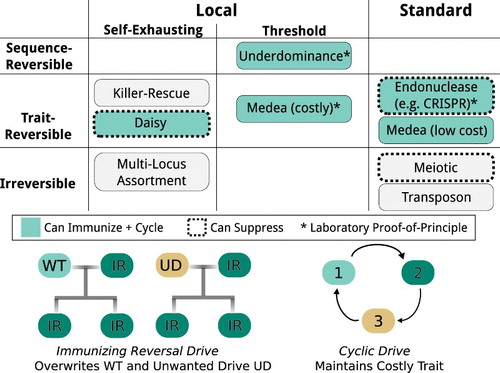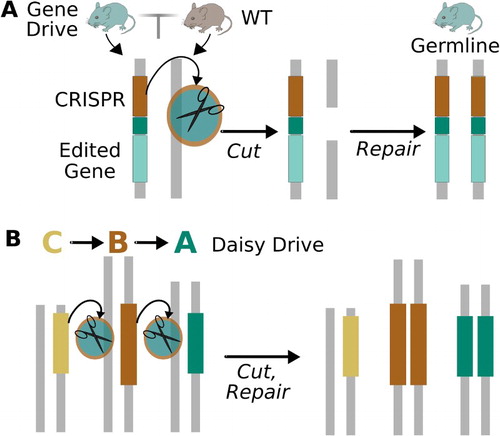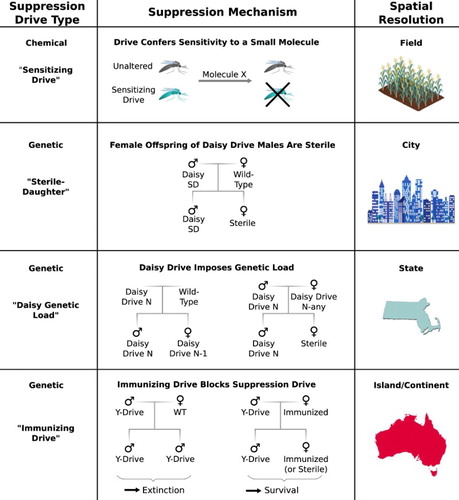Figures & data
Figure 1. Classification of gene drive systems by capacity to spread and reversibility using a subsequent drive system. Note that self-exhausting drive systems are all inherently sequence-reversible given enough time or the release of many wild-type organisms. A theoretical suppression method for Medea has been posited but is unlikely to be generalizable. Multi-locus assortment is not technically a drive system because it does not increase in frequency, but disperses to affect a larger fraction of the population.

Figure 2. The mechanism by which CRISPR gene drive systems distort inheritance. Adapted from Esvelt et al. (Citation2014).

Figure 3. (a) A standard drive system based on CRISPR encodes all components necessary to drive itself. (b) A local ‘daisy drive’ system can be created by moving the components into different genetic loci such that each element drives the next in the chain. Because the basal element does not drive, the progressive loss of daisy elements over generations constrains the spread of the resulting ‘daisy drive’ system. The power of the daisy drive system can be tuned by changing the number of elements in the daisy-chain. Adapted from Noble et al. (Citation2016).

Figure 4. Potential applications of local and standard gene drive systems. Because standard drive systems require agreement from every nation harboring the target species and likely cannot be tested in field trials without a substantial risk of unintended spread, there are only a handful of potentially feasible applications. Malaria is such a terrible scourge that any possible combination of unexpected effects would arguably be preferable to the disease itself. New World screwworm likely causes more animal suffering than any other wild species, is only present in South America, has already been eradicated from North America, and the effects of elimination can be tested locally using sterile insect technique. Desert locusts have been a hated agricultural plague in every culture afflicted since ancient times; they could be altered to remain solitary desert grasshoppers without threatening the existence of the species. Diplomatic and social barriers render other applications of standard drive systems highly unlikely; local drive systems do not necessarily face the problems.

Figure 5. Precision drive systems can safely suppress small populations by first recoding them with a local drive, or in some cases by targeting natural mutations unique to a target population. Larger populations might rely on successive standard drives for recoding, but this risks the first recoding drive spreading into other populations before it is replaced by the second recoding drive. Adapted from Esvelt et al. (Citation2014).

Figure 6. Methods of controlling the extent of population suppression using external triggers or barriers. Adapted from Esvelt et al. (Citation2014).

Figure 7. Extrinsic confinement strategies aim to prevent organisms carrying gene drive constructs from mating with wild counterparts. They are vulnerable to human error and to deliberate interference.

Figure 8. Intrinsic confinement strategies are intended to prevent population alteration even if organisms carrying gene drive constructs mate with wild counterparts. They are inherent to the organism or the gene drive system and once created are not vulnerable to human error or deliberate interference.

